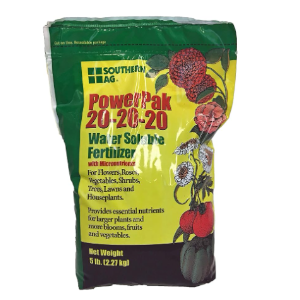Table of Contents
- Best 20 20 20 Fertilizers in the Market
- Types and Variations
- Suitable Plant Types for 20 20 20 Fertilizer
- Application and Usage Guidelines for 20 20 20 Fertilizer
- Advantages for Plant Growth
- Alternatives and Comparisons to 20 20 20 Fertilizer
- Environmental Impact of 20 20 20 Fertilizer
- Best Practices for Minimizing Environmental Impact
- Global Usage Trends of 20 20 20 Fertilizer
Best 20 20 20 Fertilizers in the Market
| Image | Product | Features | Price |
Our Pick1  | Jacks Classic All Purpose 20-20-20 Water-Soluble Fertilizer | Weight: 4 Lbs. | |
2  | EZ-gro 20 20 20 Fertilizer | Quantity: 1 Qt | |
3  | Southern Ag PowerPak 20-20-20 Water Soluble Fertilizer | Weight: 5 Lbs. |
If you’re into gardening or taking care of your plants, you’ve probably heard of 20 20 20 fertilizer. But what exactly is it? Well, 20-20-20 Fertilizer is a unique mix of nutrients designed to help your plants grow healthy and strong. It’s like a superfood for your green buddies!
This Fertilizer gets its name from its elemental composition. It contains three primary nutrients: nitrogen, phosphorus, and potassium. A number represents each of these nutrients; in the case of 20-20-20, all three numbers are the same – 20. These numbers tell you the percentage of each nutrient in the Fertilizer.
So, 20-20-20 Fertilizer is like a well-balanced meal for your plants, providing them with the nutrients they need to thrive.
Types and Variations
Let’s explore the types and variations available to suit your gardening needs.
Liquid 20-20-20 Fertilizer: One common form of this Fertilizer is the liquid version. It comes in a concentrated liquid form that you mix with water before applying it to your plants. Liquid 20-20-20 is excellent for quick absorption by the roots, providing a fast nutrient boost. You can use it in a watering can or with a hose-end sprayer for easy application.
Granular 20-20-20 Fertilizer: Another option is the granular form of 20-20-20 Fertilizer. This type comes in small pellets or granules that you spread around the base of your plants. Granular fertilizers release nutrients slowly over time, providing a longer-lasting benefit. They’re ideal for plants that require a steady supply of nutrients.
Water-Soluble 20-20-20 Fertilizer: Some 20-20-20 fertilizers are designed to be water-soluble, which means they dissolve quickly in water. This makes them convenient for foliar feeding (spraying on plant leaves) and root application. Water-soluble 20-20-20 fertilizers offer versatility in how you choose to nourish your plants.
Controlled-Release 20-20-20 Fertilizer: If you prefer a “set-it-and-forget-it” approach, controlled-release 20-20-20 fertilizer may be your choice. These pellets or capsules slowly break down over time, continuously supplying nutrients to your plants. They’re excellent for busy gardeners who want consistent and gradual feeding.
Specialty Blends: Besides these basic types, you can find specialty blends of 20-20-20 Fertilizers designed for specific plant types or growth stages. For instance, formulations are tailored for flowering plants, fruiting trees, or even indoor houseplants. These variations ensure your plants receive the proper nutrients at the right time.
Choosing the right type and variation of 20-20-20 Fertilizer depends on your gardening goals and the specific needs of your plants. Whether you prefer liquid for quick results, granular for long-term care, or a specialized blend, a 20-20-20 fertilizer option suits your green thumb!
Suitable Plant Types for 20 20 20 Fertilizer



Houseplants: If you have indoor plants like pothos, spider plants, or peace lilies, a 20-20-20 Fertilizer can be a fantastic choice. It provides the balanced nutrition these plants need to thrive in the limited conditions of your home.
Garden Vegetables: Growing tomatoes, peppers, or cucumbers in your garden? 20-20-20 Fertilizer can help boost their growth and yield. These vegetables appreciate the balanced nutrients for strong roots, healthy foliage, and abundant fruits.
Flowering Plants: Plants that bloom with vibrant flowers, like roses, petunias, and marigolds, also benefit from 20-20-20 Fertilizers. It supports not only their beautiful blossoms but also overall plant health.
Fruit Trees: If you have fruit trees in your orchard, such as apple or peach trees, you can use 20-20-20 Fertilizers to promote fruit production—the nutrients aid in tree growth and the development of juicy, delicious fruits.
Lawns: Even your grass can enjoy the advantages of 20-20-20 Fertilizer. It helps maintain a lush, green lawn by providing essential nutrients that keep the grass healthy and robust.
Indoor Herb Gardens: Herbs like basil, parsley, and mint thrive with the balanced nutrition of 20-20-20 Fertilizer. You can grow these aromatic herbs indoors and enjoy fresh seasonings for your culinary creations.
Ornamental Shrubs: Shrubs like azaleas, hydrangeas, and hibiscus can benefit from 20-20-20 Fertilizers to enhance foliage and flower production, adding beauty to your landscape.
In essence, 20-20-20 Fertilizer is versatile and suitable for various plant types. However, it’s essential to understand the specific needs of your plants and adjust the application frequency and dosage accordingly. By doing so, you can ensure that your green friends receive the proper care and attention to flourish and thrive.
Application and Usage Guidelines for 20 20 20 Fertilizer
Now that we know about the popularity of 20-20-20 Fertilizer, let’s dive into how to use it effectively to help your plants thrive. Here is a short video if you are more of a video person
When to Apply
Timing matters when it comes to fertilizers. Generally, it’s best to apply 20-20-20 Fertilizer during the growing season. For most plants, this means spring and summer when actively growing. Avoid fertilizing during the dormant winter months.
How to Apply
The application method depends on the type of 20-20-20 Fertilizer you have. If it’s liquid, dilute it according to the instructions on the label and water your plants with it. For granular forms, evenly distribute the pellets around the base of the plants and water thoroughly to help the nutrients penetrate the soil.
Frequency of Application
Follow the recommended dosage on the fertilizer packaging or the guidance provided by the manufacturer. Over-fertilizing can harm your plants, so sticking to the suggested application rates is essential. Generally, a balanced fertilizer like 20-20-20 may be applied every 4-6 weeks during the growing season.
Foliar Feeding
You can use 20 20 20 Fertilizer as a foliar spray for an extra boost. Dilute it with water and apply it directly to the leaves. This method provides a quick nutrient uptake through the foliage, which is especially useful for plants with nutrient deficiencies.
After applying 20-20-20 Fertilizers, make sure to water your plants thoroughly. This helps the nutrients seep into the root zone, where the plants can absorb them. Proper watering ensures that your plants get the most benefit from the Fertilizer.
Avoid Overlapping
Be careful not to overlap the Fertilizer when spreading granules. Overlapping can lead to uneven nutrient distribution and potentially harm your plants. Follow the recommended spreading instructions for the specific type of granular Fertilizer you’re using.
By following these guidelines for when, how, and how often to apply 20-20-20 Fertilizers, you can ensure that your plants receive the nourishment they need without the risk of overfeeding or damaging them. Healthy and thriving plants will reward you for taking care of them with the proper fertilizer regimen.
Advantages for Plant Growth
Now, let’s explore the many benefits that 20-20-20 fertilizer offers to plants.
Balanced Nutrition: 20-20-20 Fertilizer provides a well-rounded mix of nutrients – nitrogen, phosphorus, and potassium – equal proportions. This balance ensures that plants get the essential elements for overall growth and health.
Healthy Greenery: The nitrogen in 20-20-20 Fertilizers promotes lush green foliage. This means your plants will have vibrant and robust leaves, making them look their best.
Strong Roots: Phosphorus is a crucial element for root development. With 20-20-20 Fertilizers, your plants will grow sturdy and extensive root systems, which anchor them securely in the soil.
Flower Power: 20-20-20 Fertilizer can be your secret weapon if you love flowers. Its phosphorus and potassium encourage abundant and colorful blooms, making your garden a visual delight.
Fruitful Harvest: For fruit-bearing plants, this Fertilizer is a game-changer. The balanced nutrient blend supports the production of more significant and juicier fruits, ensuring a bountiful harvest.
Disease Resistance: Potassium, one of the main components of 20-20-20 Fertilizers, helps plants build resistance against diseases and stressors. This means plants are less likely to fall victim to pests or infections.
Quick Nutrient Uptake: Liquid forms of 20-20-20 Fertilizer can be absorbed rapidly by plant roots and leaves. This means your plants get an immediate nutrient boost, which is especially useful in times of nutrient deficiency.
Versatility: 20-20-20 Fertilizer is versatile and suits various plant types, from indoor houseplants to outdoor garden vegetables. Its adaptability makes it a go-to choice for many gardeners.
Overall Plant Health: When your plants receive the right balance of nutrients, they are healthier, more resilient, and better equipped to thrive in their environment.
In a nutshell, 20-20-20 Fertilizer is a powerhouse of plant nutrition, promoting robust growth, vibrant foliage, abundant flowering, and a healthier and more beautiful garden or indoor space. It’s like a recipe for plant success!
Alternatives and Comparisons to 20 20 20 Fertilizer
While 20-20-20 Fertilizer is popular, it’s essential to know that other options are available. Let’s take a look at some alternatives and how they compare:
Organic Fertilizers
If you prefer natural options, organic fertilizers can be a great choice. They’re made from raw materials like compost, manure, and plant-based ingredients. While they may release nutrients more slowly than 20-20-20, they improve soil health and are environmentally friendly.
Slow-Release Fertilizers
These fertilizers provide nutrients to plants gradually over an extended period, reducing the need for frequent applications. They can be convenient for busy gardeners and help prevent over-fertilization.
Specialty Fertilizers
Some plants have specific nutrient requirements. Specialty fertilizers are tailored to meet these needs. For example, citrus trees benefit from a fertilizer with extra potassium for fruit production.
Comparing Nutrient Ratios
When choosing a fertilizer, look at the nutrient ratios. 20-20-20 has an equal balance of N-P-K (nitrogen, phosphorus, and potassium). Other fertilizers may have different ratios, which can be better suited to certain plants or soil conditions.
Environmental Impact of 20 20 20 Fertilizer
Positive Environmental Impact
20 20 20 Fertilizer, when used correctly, can have some positive environmental effects. Providing plants with the proper nutrients helps them grow stronger and healthier. Healthy plants can better resist pests and diseases, reducing the need for harmful pesticides. Additionally, well-nourished plants can absorb carbon dioxide from the air, contributing to a cleaner environment.
Negative Environmental Impact
However, there are potential adverse impacts to be aware of. If 20-20-20 Fertilizers are overused or misapplied, excess nutrients can leach into nearby water bodies, causing water pollution. This can lead to problems like algal blooms, which harm aquatic ecosystems. Moreover, the production and transportation of fertilizers can contribute to greenhouse gas emissions and energy consumption.
Best Practices for Minimizing Environmental Impact
Gardeners should follow best practices to minimize the negative environmental impact of 20 20 20 Fertilizers. These include:
Proper Application: Use the Fertilizer as directed on the packaging, and avoid excessive or frequent applications.
Water Management: Water your plants wisely, ensuring excess water doesn’t wash away Fertilizer into waterways.
Storage: Store fertilizers in a dry and secure place, away from children and pets, to prevent accidental spills or contamination.
Alternative Options: Consider organic or slow-release fertilizers, which can be gentler on the environment.
Soil Testing: Perform soil tests to accurately determine your garden’s nutrient needs so you only apply Fertilizer when necessary.
By following these practices, you can enjoy the benefits of 20-20-20 Fertilizer while minimizing its potential environmental harm. Remember, responsible gardening helps create a greener and healthier world for everyone.
Global Usage Trends of 20 20 20 Fertilizer
Now, let’s look at how popular and widely used 20-20-20 Fertilizer is worldwide.
Popularity Across Continents:
20-20-20 Fertilizer is a globally recognized product, and its popularity spans across continents. Gardeners and farmers in North America, Europe, Asia, and beyond use this Fertilizer to nourish their plants.
Farming and Agriculture:
In agriculture, 20 20 20 Fertilizers find extensive use in crop production. Large-scale farms often rely on this balanced nutrient blend to support the growth of various crops, including grains, fruits, and vegetables.
Horticulture and Gardening:
In gardening and horticulture, 20-20-20 Fertilizer is a go-to choice for enthusiasts. Whether you’re tending to a small backyard garden or a lush botanical park, this Fertilizer is trusted for its effectiveness.
Commercial and Residential Use:
It’s not just big farms and gardens; even individual homeowners use 20-20-20 Fertilizers to care for their lawns, flower beds, and potted plants. Its availability in different forms makes it accessible for commercial and residential use.
Adaptation to Local Conditions:
One exciting aspect of the global usage of 20-20-20 Fertilizer is its adaptation to local conditions. Different regions have specific plant varieties and climate conditions, and gardeners often adjust their fertilization strategies accordingly.
Environmental Considerations:
As awareness of environmental sustainability grows, some areas are exploring eco-friendly alternatives and practices to reduce the environmental impact of fertilizers, including 20-20-20. This trend reflects a broader shift towards more responsible and sustainable gardening and farming practices.
In summary, 20 20 20 Fertilizers enjoy widespread popularity and use worldwide, serving both large-scale agricultural operations and individual gardening enthusiasts. Its adaptability and effectiveness make it a versatile choice for nourishing various plants. However, efforts to minimize its environmental impact are also gaining traction in many regions.

